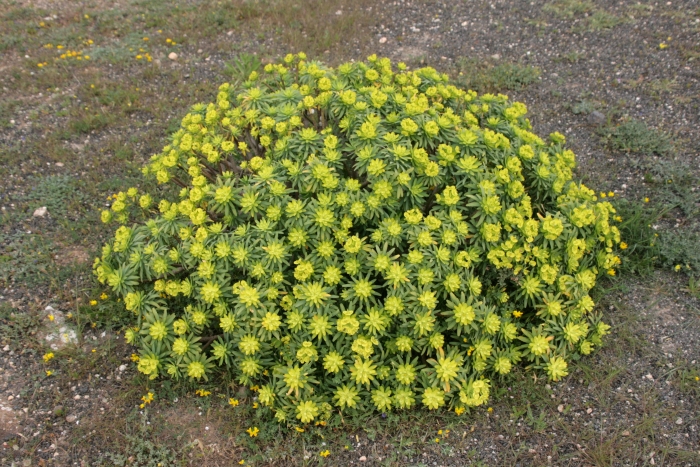King Juba’s Euphorbia
(Euphorbia regis-jubae)
King Juba’s Euphorbia (Euphorbia regis-jubae)
/
/

Frank Vincentz
CC BY-SA 3.0
Image By:
Frank Vincentz
Recorded By:
Copyright:
CC BY-SA 3.0
Copyright Notice:
Photo by: Frank Vincentz | License Type: CC BY-SA 3.0 | License URL: https://creativecommons.org/licenses/by-sa/3.0 | Uploader: Ies | Publisher: Wikimedia Commons | Title: Teguise_-_Camino_de_Teguise_al_las_Nieves_-_Euphorbia_regis-jubae_08_ies.jpg | Notes: |


















Estimated Native Range
Summary
Euphorbia regis-jubae, commonly known as King Juba’s Euphorbia, is an evergreen succulent native to the semi-arid shrublands and rocky areas of the Canary Islands and Morocco. It can grow up to 2 meters (7 feet) tall and is characterized by its light brown, thick, fleshy stems that bear terminal rosettes of narrow, oblong leaves with a pointed or somewhat blunt apex. During the winter and spring, it produces inconspicuous green and yellow flowers that are typical of the Euphorbiaceae family. The plant’s sap is toxic and can cause skin irritation.
King Juba’s Euphorbia is valued for its architectural form and drought tolerance, making it suitable for xeriscaping and as a focal point in rock gardens or Mediterranean-style landscapes. It is also used in coastal planting due to its salt tolerance. In cultivation, it requires minimal maintenance, thriving in part shade to full sun and preferring well-drained soils. Overwatering should be avoided to prevent root rot. While it is generally pest-resistant, mealybugs and spider mites can sometimes be a problem. Due to its toxic sap, care should be taken when handling this plant, especially during pruning or repotting.CC BY-SA 4.0
King Juba’s Euphorbia is valued for its architectural form and drought tolerance, making it suitable for xeriscaping and as a focal point in rock gardens or Mediterranean-style landscapes. It is also used in coastal planting due to its salt tolerance. In cultivation, it requires minimal maintenance, thriving in part shade to full sun and preferring well-drained soils. Overwatering should be avoided to prevent root rot. While it is generally pest-resistant, mealybugs and spider mites can sometimes be a problem. Due to its toxic sap, care should be taken when handling this plant, especially during pruning or repotting.CC BY-SA 4.0
Plant Description
- Plant Type: Shrub, Succulent
- Height: 4-6 feet
- Width: 4-6 feet
- Growth Rate: Moderate
- Flower Color: Green, Yellow
- Flowering Season: Winter, Spring
- Leaf Retention: Evergreen
Growth Requirements
- Sun: Part Shade
- Water: Very Low, Low
- Drainage: Fast, Medium
Common Uses
Bank Stabilization, Bee Garden, Bird Garden, Border Plant, Butterfly Garden, Deer Resistant, Drought Tolerant, Fire Resistant, Low Maintenance, Potted Plant, Rabbit Resistant, Salt Tolerant, Showy Flowers
Natural Habitat
Semi-arid shrublands and rocky areas
Other Names
Common Names: Tabaiba Morisca
Scientific Names: , Euphorbia mauritanica, Euphorbia regis-jubae, Euphorbia obtusifolia subsp. regis-jubae, Euphorbia capazii, Euphorbia lamarckii subsp. regis-jubae, Euphorbia lamarckii f. latibracteata, Euphorbia lamarckii var. pseudodendroides, Euphorbia obtusifolia f. latibracteata, Euphorbia obtusifolia var. pseudodendroides
GBIF Accepted Name: Euphorbia regis-jubae J.Gay